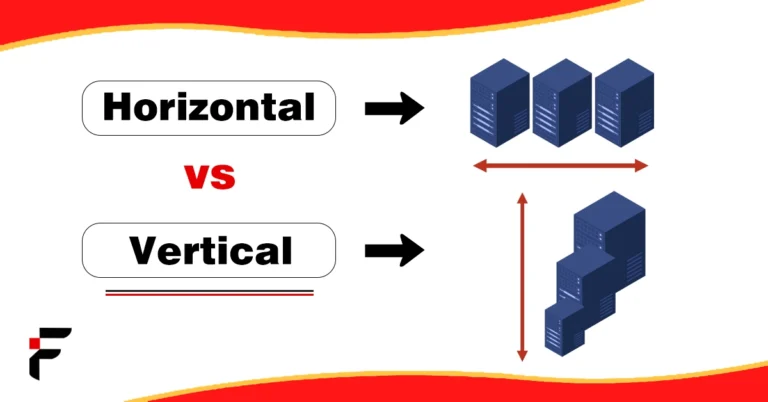Aren’t you always confused in the battle of horizontal vs vertical? Don’t worry, this article will eliminate the confusion for you once and for all! The key difference between the terms, in simple words, is that anything lying flat, from left to right, is horizontal, whereas something upwardly erect is vertical.
However, that’s not all. These are not just the terms referring to the directions of certain objects. Rather, these describe different approaches, structures, and strategies. The article aims to clarify this confusion between horizontal vs vertical when used in multiple contexts.
1. What is Horizontal?
Consider a straight line, moving from right to left without going upwards. Such a line is a horizontal line.
Anything assimilating in a way that it doesn’t go up or down, rather expands left to right, would be called horizontal in all contexts.

2. What is Vertical?
Now, consider a line moving upwards, or coming down without going left or right. It is a vertical line.
When any interaction between two components or people is done in a way that involves upper and lower parts or ranks, it would be called vertical in all contexts.

Key Differences Between Horizontal vs Vertical in Different Contexts
| Context | Horizontal | Vertical |
|---|---|---|
| Business Integration | Merging with companies at the same supply chain level | Merging with companies at a different supply chain level |
| Financial Report Analysis | Comparing financial data across different time periods | Comparing financial data within the same time period to understand proportions |
| Scaling | Adding more servers/ instances to distribute workload (scaling out) | Adding resources (CPU, RAM, etc) to a single server system (scaling up) |
| Communication | Communication among employees at the same level | Communication between employees and their subordinates and superiors |
Understanding the distinctions between horizontal and vertical orientations is crucial across various fields, including business, technology, and education.
Orientation:
- A horizontal line extends from left to right, parallel to the horizon.
- A vertical line stands upright and runs up and down.
In Geometry:
- A horizontal line is parallel to the x-axis.
- A vertical line parallel to the y-axis.
Example of Horizontal and Vertical
Below are some of the examples of the horizontal and verticle to understad these in better way.
Horizontal:
- A book on a table lies horizontally.
- A tree expands horizontally in width.
Vertical:
- A tall building stands vertically.
- A tree grows vertically in length.
Key Differences in Multiple Contexts
As mentioned above, the differences between the terms vary depending upon the context in of their usage.
1. Horizontal vs. Vertical Integration:
In the world of business, every businessman tries to grow and compete with other businesses. The most popular approaches used for this growth are called horizontal and vertical integration.
- In Horizontal Integration, a company uses such a process of production that it expands by operating and merging with other companies at the same supply chain level.
- In Vertical Integration, a company acquires or merges with other companies from different stages of the supply chain. The company expands by assimilating with upstream suppliers and downstream retailers.
These approaches are for the benefit of the business. They serve many purposes like;
- Increase the efficiency of the business through shared resources and infrastructures.
- Enhance the market power of a product.
- Reduce the overall costs by controlling the entire supply chain.
- Reduce the dependence of the business on other businesses.
2. Horizontal vs. Vertical Analysis:
Are you struggling with analysing the financial statement of your startup? Or does your business follow outdated methods, but you want to stay updated? You can perform the financial statement of a company in many ways. However, the most common approaches of the modern world are horizontal and vertical analysis:
- In Horizontal Analysis, the financial data of the company is compared across different periods to identify trends and changes. It is the best approach to identify growth or decline in the business as well as the relevant trends.
- In Vertical Analysis, the data is compared with the same line items within the same period to understand their relative proportions. It helps in the understanding of the composition of a financial statement by expressing every line item as a percentage.
Such analytical methods are integral to financial education and learning to enable professionals to make informed decisions.
3. Horizontal vs. Vertical Scaling:
Computer systems often need to be scaled up or out. This scaling is alternatively also called Horizontal Scaling (scaling out) and Vertical Scaling (scaling up).
- Horizontal Scaling refers to the addition of more instances and servers to a system to distribute the workload over multiple machines. This introduces more fault tolerance and higher scalability into the system.
- Vertical Scaling is the addition of resources (like CPU, RAM, etc) to a single server or system to handle more workload. It is simpler to manage or implement and is also very cost-effective.
4. Vertical and Horizontal Communication:
You’ve read that right. The terms vertical and horizontal communication has very common usage in formal settings. Here is how;
- Horizontal communication: When the employees of a company or different workers of the same level communicate between themselves.
- Vertical communication: When the higher-ups communicate with the employees they manage or the workers communicate with their superiors.
Effective communication strategies are often emphasized in leadership training and career development programs, such as those offered by different organzations.
Final Summary
From language to business, there is almost no such domain where the term horizontal vs. vertical doesn’t have relevance. It is therefore important to know the distinction between these.
Understanding the differences between horizontal vs vertical integration, analysis, scaling, communication, and others can help individuals and organizations make informed decisions, optimize resources, and achieve their goals. One just needs to keep in mind the directions associated with these terms, and the contextual understanding then becomes a piece of cake.


